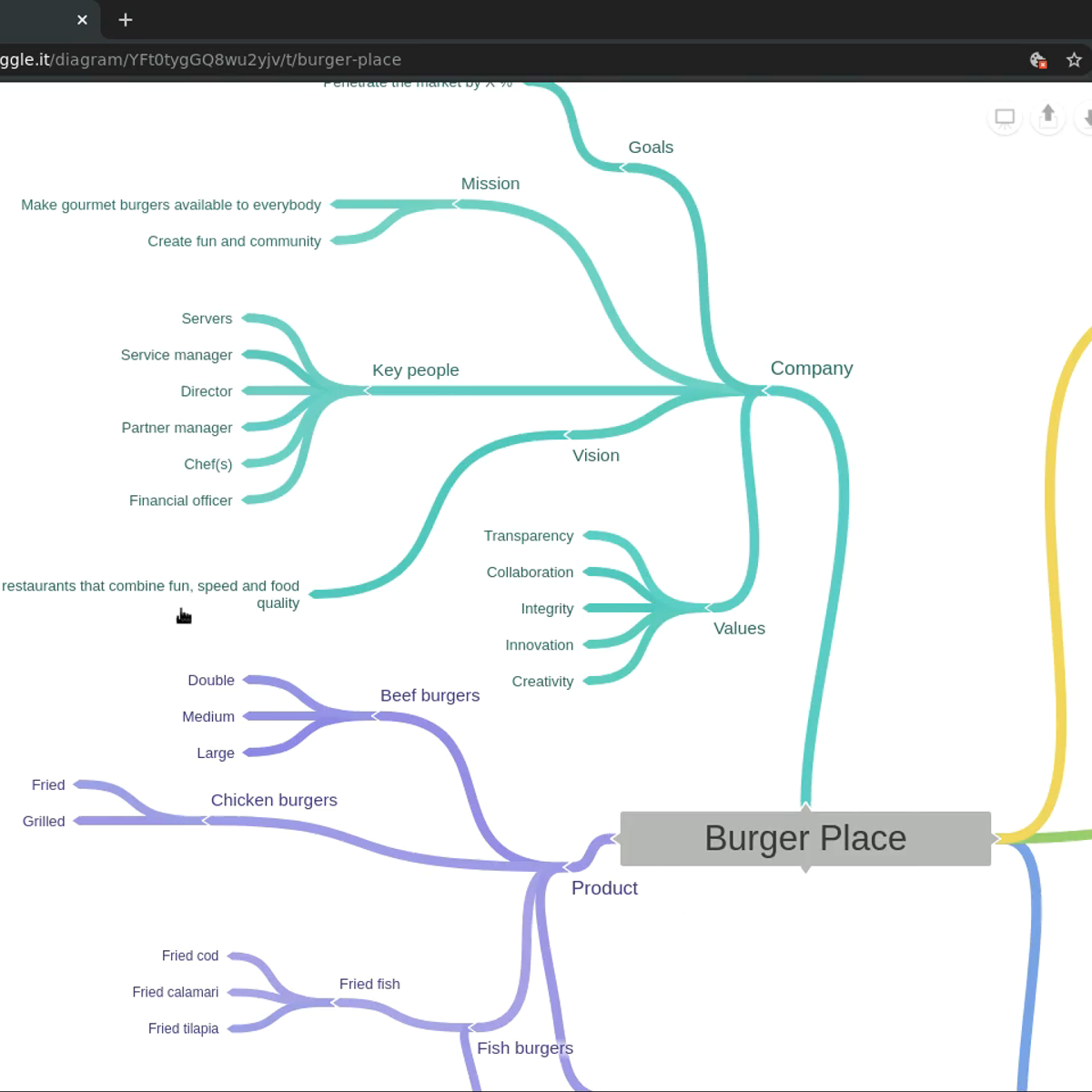Back to Courses









Entrepreneurship Courses - Page 20
Showing results 191-200 of 222

Coding for Designers, Managers, & Entrepreneurs III
Do you want to experience what it is to go from idea to code? If so, this is the place for you! This is the third course in the Coding for Designers, Managers, and Entrepreneurs Specialization. If you’re a hands-on collaborator with developers, this course is specifically designed for you. In this course, we’re going to focus on creating application logic (controllers) with Javascript, including interfaces to external API's and resources you can leverage to do a lot quickly. Coding for Designers, Managers, and Entrepreneurs III and its specialization will help you build a creative confidence and competence that will make you an even better collaborator on digital projects. This course was developed at the Darden School of Business at the University of Virginia and is taught by top-ranked faculty.

Create a business mind map with Coggle
In this 1-hour long project-based course, you will learn how to build a business plan mind map using Coggle. You will create branches with keywords stemming from a central idea, analyze product and market fit, services, company structure and summarize an executive overview. You will learn how to use signifiers to organize information and establish hierarchies. Finally you will share, comment and manage revision history for solid collaboration.
Note: This course works best for learners who are based in the North America region. We’re currently working on providing the same experience in other regions.

Create an online presence with a free website from WordPress
In this 1-hour long project-based course, you will learn how to
- create a free web presence on WordPress
- design your site
- publish your website
Note: This course works best for learners who are based in the North America region. We’re currently working on providing the same experience in other regions.

How to Use the Business Model Canvas for Strategic Analysis
In this 2-hour long project-based course, you will be able to design, analyze, and innovate with the business model canvas as we work you through the 9 building blocks that make up the canvas. You will be able to conceptualize how it all begins with strategy and how having the right strategy determines how you approach each of the blocks. We will use a spreadsheet to sketch and analyze the business model canvas, and innovatively fill up each of the blocks. We will work you through the process with our social venture to conduct the analysis, as that would empower you to apply the concepts to analyze any organization. This project is for entrepreneurs and innovators who want to have a holistic understanding of how to analyze their venture and create a strategy that puts all factors into consideration. Also, for intrapreneurs who are interested in creating a venture out of an existing business, or analyzing their current business. All you need to have is a business idea you want to implement, and we will work you through the model step-by-step. At the end of the project, you will be able to design, analyze, and innovate strategically with the business model canvas.

From Likes to Leads: Interact with Customers Online
From Likes to Leads: Interact with Customers Online is the third of seven courses in the Google Digital Marketing & E-commerce Certificate. This course will help you develop social media marketing strategies. Social media is a key digital marketing channel for many businesses because of the large number of people who use social platforms to socialize, interact with businesses, and share content. No digital marketing strategy is complete without an online brand presence where customers can engage with a brand. In this course you’ll explore social media platforms and identify which platform is the most appropriate for specific business needs. You’ll learn how to create content for social media using graphic design principles for marketers and learn how to manage a social media presence. In addition you’ll set goals and success metrics for social media ads.
Google employees who currently work in the field will guide you, providing hands-on activities and examples that simulate common digital marketing and e-commerce tasks while showing you some of the best tools and resources used on the job.
Learners who complete the seven courses in this program will be equipped to apply for entry-level jobs in digital marketing and e-commerce. No previous experience is necessary.
By the end of this course, you will be able to do the following:
- Identify the five core pillars of social media marketing: strategy, planning and publishing, listening and engagement, analytics and reporting, and advertising
- Determine how to choose social media platforms for a campaign
- Understand how to boost engagement on social media
- Learn how to write, design, and repurpose engaging content for social media
- Recognize how to use the data gathered from social media analytics as a decision-making tool
- Learn best practices for presenting a social media report
- Achieve specific marketing goals through the use of paid social media

Patenting in Biotechnology
Far too often, researchers are misinformed about the role and the possibilities arising around patents and Intellectual Property Rights (IPR). In this course we will teach you what IPR are - with a special focus on patents. Also this course will look at the importance of patents in the world of biotechnology - and what you actually can patent.
Should your research be protected? Can your research even be protected?
There are a lot of misunderstandings about patents, so first step is to know what patents really are and how they work. Then we will introduce how and when to apply for them. Also how to find existing patents is a crucial and necessary element to being able to assess whether your research should be protected or not.
The course will be divided in 7 sessions, and at the end of the course, you should be able to:
- describe the different types of IPR
- explain the conditions of patentability for an invention
- describe the various stages involved in a patent application
- search and retrieve patent information from databases
- read and understand a patent
- write claims related to biotechnology
- understand and explain the concept of Freedom To Operate
Course Materials:
You will need the following book as a reading material for the course:
“Patenting in Biotechnology, a laboratory manual” by Peter Ulvskov, which will be available from
http://polyteknisk.dk/home/Detaljer/9788750211068
Also, you will need to get access from your home institution to these databases:
- Derwent Innovation Index (via Web of Science)
- SciFinder
NB:
This course is related to a 5 ECTS point course that is a mandatory requirement for access to the BioBusiness and Innovation Platform (BBIP) program at the Copenhagen Business School. NOTE: this Coursera course will NOT be sufficient for attending the BBIP program but successful completion of this course (with a Course Certificate) will be a plus for applying to the BBIP.
To obtain the 5 ECTS points, you will have to enrol as a DTU Student, participate on a hands-on workshop on patent databases and pass an exam in presence of an external Censor. For more information, please email me at:
fdemasi@cbs.dtu.dk
Link for BBIP: (http://www.cbs.dk/viden-samfundet/strategiske-indsatsomrader/biobusiness-and-innovation-platform-bbip)

Fundamentals of Management, with Goldman Sachs 10,000 Women
This free online course is one of 10 courses available in the Goldman Sachs 10,000 Women collection, designed for entrepreneurs ready to take their business to the next level.
This course focuses on the most critical resource for growth in your business – your employees. Understanding of human resource management covers topics from employee recruitment and selection to performance management and training and development.
You will plan how to develop the team needed to achieve your vision for your business, while promoting a strong organizational culture that supports business growth. By the end of this course, you will have aligned your vision with your organizational structure, considered when it is beneficial to outsource or delegate, and reflected on performance management in your business.
To help prepare you for this course, you may wish to take one of the other Goldman Sachs 10,000 Women courses, ‘Fundamentals of Leadership’, in which you will develop a Vision Statement and examine your leadership style.
The 10,000 Women course collection offers a truly flexible online learning experience. You have the freedom to approach the program in any way that works for you – take any course, or combination of courses, to tailor your learning journey to your individual business growth needs. If you choose to take all 10 courses, you will explore all the key elements of your business and develop a thorough plan for your business’s growth.
You can find out more about the Goldman Sachs 10,000 Women collection in the FAQs.

How to find customers by uploading contacts on Twitter
By the end of this project, you will be able to sign up for a business Twitter account and find and connect with your existing customer base on Twitter. This will allow you to better target your current customers with upcoming offers and enable you to connect to future customers.
Twitter is exceptionally good at creating sustained interest and has almost unlimited ways to connect with new customers, which is different from other online platforms, such as Facebook or Instagram. By finding your existing customers here, and then incorporating several unique Twitter features, you can grow your business fast!

Identifying Social Entrepreneurship Opportunities
This Course will clarify the definition and meaning of Social Entrepreneurship and will focus on the need to learn about the source and root of a social problem. You will be introduced to different perspectives about Social Entrepreneurship and you will learn about complementary and opportunistic assets which will help you to detect an opportunity and develop an idea of how to create a business for social change.
From a practical perspective you will be asked to initiate a team formation process and start to think about a problem topic that you want to address with your social venture in the future. You will work in a team to research this topic and will gradually start to think about a particular opportunity and identify a purpose for your social venture project.

Creating a Product-Market Fit with Value Proposition Canvas
By the end of this guided project, you will be able to use the Value Proposition Canvas (VPC) to position your products and services around what your customers truly value or need. The value proposition is the place where your company’s product intersects with your customer’s desires. It’s the magic fit between what you make and why people buy it. And for us to practically demonstrate how the fit is created, we will analyze a Social Venture startup. The example of the case study would empower you to use the model to analyze your startup or any other company of your choice. The project is for entrepreneurs who want to test their product-market fit. Also, for intrapreneurs who want to modify their existing products, or more importantly, develop new ones that truly reflects the needs of the customers. At the end of the project, you will be able to use the Value Proposition Canvas to differentiate your offering from competition
Popular Internships and Jobs by Categories
Find Jobs & Internships
Browse
© 2024 BoostGrad | All rights reserved